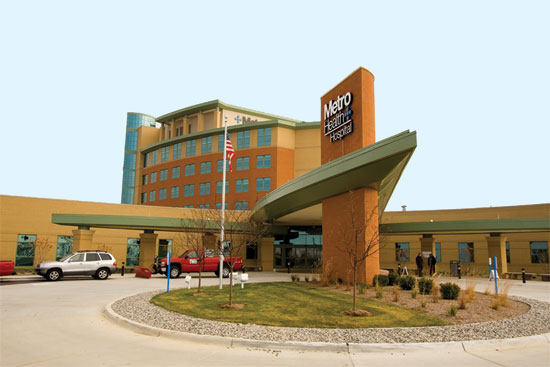Door Opening Solutions in LEED for Healthcare
Energy and Atmosphere (EA) and Door Openings
Energy-efficient buildings under the LEED for Healthcare items are addressed in a similar manner to other buildings in that the building envelope and total building performance are critical elements of demonstrating energy efficiency.
Relevant LEED EA Credits
The areas where high-performance door openings can make an energy impact include the following:
EA Prerequisite 2 – Minimum Energy Performance. This is the entry level of energy performance mandated by the rating system with three options to show compliance.
• Under option 1, Whole Building Energy Simulation, the computer-modeled performance of the design of new building projects must demonstrate a minimum 10% improvement in energy efficiency compared to a calculated baseline building using ASHRAE 90.1-2007. For major renovations to existing buildings, a 5% improvement must be demonstrated compared to the ASHRAE 90.1-2007 baseline.
• Option 2 allows for demonstrating minimum energy performance by using a Prescriptive Compliance Path based on the ASHRAE Advanced Energy Design Guide (AEDG) for Small Hospitals and Healthcare Facilities. To use this option, a few criteria must be met: Buildings must be 90,000 square feet or less; project teams must fully comply with all applicable criteria as established in the AEDG for the climate zone in which the building is located; the specific limits in AEDG Small Hospitals must be met for U-factors and air leakage including those for exterior doors in different climate zones.
• Option 3 is also a Prescriptive Compliance Path but based on the Green Guide for Health Care (GGHC) v2.2 – Prescriptive Path for Energy Improvements in Hospitals. In order to use this option, buildings must be over 90,000 square feet; the mandatory provisions of Sections 5.4, 6.4, 7.4, 8.4, 9.4 and 10.4 in ASHRAE Standard 90.1-2007 must be met; and all relevant Energy Efficiency Measures (EEMs) listed in the GGHC must be met including specific requirements for high-performance window and door glazing, frame, and panels.
 |
LEED for Healthcare® is appropriate for use in new or renovation projects for inpatient and outpatient care facilities as well as long-term care facilities. Photo courtesy of ASSA ABLOY |
EA Credit 1 – Optimize Energy Performance (1 – 24 points). Energy and Atmosphere Credit 1 represents up to 24 out of the 100 possible total base points in LEED and rewards increasing levels of energy performance beyond the prerequisite standards. For new buildings, that means demonstrating energy savings of greater than 10 percent. For every 2 percent increase in savings, 1 or 2 points are earned. Hence, a demonstrated 12 percent savings earns 1 point, 14 percent earns 2 points, 20 percent earns 7 points and so forth up to a maximum of 48 percent savings that earns 24 points. For existing buildings, the process is similar, but since the prerequisite level is 5 percent, the first point is earned at 8 percent energy savings, with a scale up to a maximum of 44 percent earning the maximum 24 points. Clearly, the more energy-reducing strategies employed in a building design, the more points that are earned. Designs that exceed the stated maximums may be eligible for additional points under innovation credits.
EA Credit 3 – Enhanced Commissioning (1 – 2 points). This credit is in addition to EA Prerequisite 1: Fundamental Commissioning of Building Energy Systems. Among the things addressed to earn points under EA Credit 3 is commissioning of the building envelope in accordance with the LEED Reference Guide for Green Building Design and Construction, 2009 Edition Healthcare Supplement. One point is available under this credit for designating an independent commissioning authority (CxA). An additional point is available if that CxA commissions the building's thermal envelope systems. The building thermal envelope entails all exterior wall assemblies separating a building's conditioned spaces from outdoor ambient conditions, including: roof assemblies, vapor barriers, air barrier systems, flashings, cladding and siding, windows, curtain-wall assemblies, and of course exterior door openings.
Optimizing thermal performance requires careful consideration of the entire building envelope. MasterFormat Division 8 specifications should therefore reflect the need to create a sealed barrier that prevents air infiltration and unnecessary energy loss. Each opening component—the proper-sized door closer, insulated doors, thermal break frames, gasketing, as well as alternatives like revolving doors—must be carefully chosen to ensure maximum energy savings are achieved. Doors, frames, and hardware are examples of building components that, although small in the scope of the overall project, can have a big impact on the energy efficiency of buildings. With all of the aforementioned in mind, the following basic strategies related to door openings come into play to achieve the desired performance levels.









